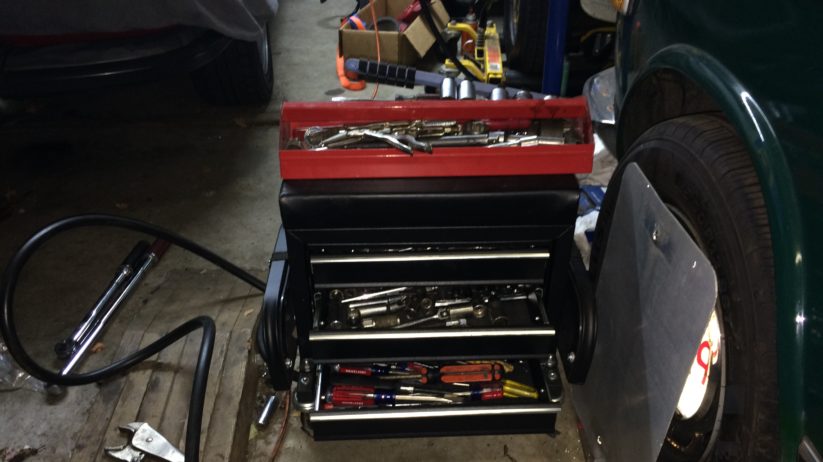As I’ve written, although I’m blessed to have an attached garage into which I can easily fit three cars, it is a cramped space. It’s even worse when I use wheel dollies, a winch, a shoehorn, and lube to squeeze in a fourth car over the winter.
But the cramped real estate affects more than just the cars. It has a major effect on the tools and how they’re stored and accessed.
I have a two-piece, three-level Craftsman tool chest (or, as it says on the front, “tool station”) that my family bought me probably 35 years ago. Despite the large-sounding description and its actual physical size, it’s never worked terribly well for me. There’s nothing wrong with the top part, with its four drawers and under-lid area you’d expect of a full-size tool box, but the bottom section is inefficient: The middle level has only two drawers, and they’re much too big to dedicate to a single organizational task. Like holding, for example, 1/2″ metric sockets. And the bottom level consists of a single area with a lift-up garage-door-style cover, making it useless for anything except a handful of big bulky items like spring compressors. I wind up throwing stuff like air tools and ball joint separators in there, then having to pull big things out in order to find what I’m looking for. A unit with same-size drawers all the way down would be far more useful to me. If I ever move and can start with a clean slate, I might look for one, but I’ve spent 35 years dancing with the girl I was fixed up with at the party.
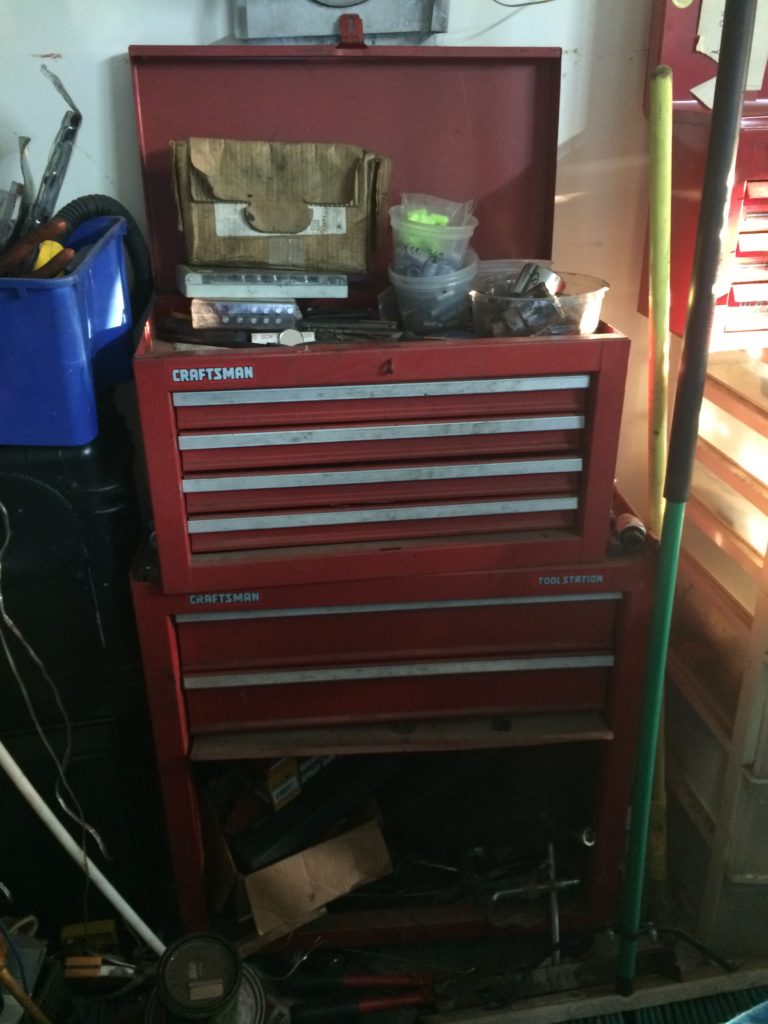
The old workhorse Craftsman tool chest: imposing, but not optimal.
Over the years, I found that what seemed to work best was having three medium-size plastic storage boxes, not even the size of regular tool boxes, each of which could be easily picked up and put right next to whatever I was working on. One held all my 22-mm and smaller wrenches, another all my 22-mm and smaller 1/2″ and 3/8″ sockets, ratchets, and extensions, and a third all my screwdrivers and pliers. There’s a fourth little box for 1/4″ wrenches and sockets, whose main purpose, let’s all admit, is so I can find the 10-mm socket quickly. For bigger things like the torque wrench, breaker bar, pry bar, big slip-joint pliers (or, as I learned from Terry Sayther to call them, the BFPs), and the like, I needed to go back to the big tool box, but even still, this arrangement worked pretty well.
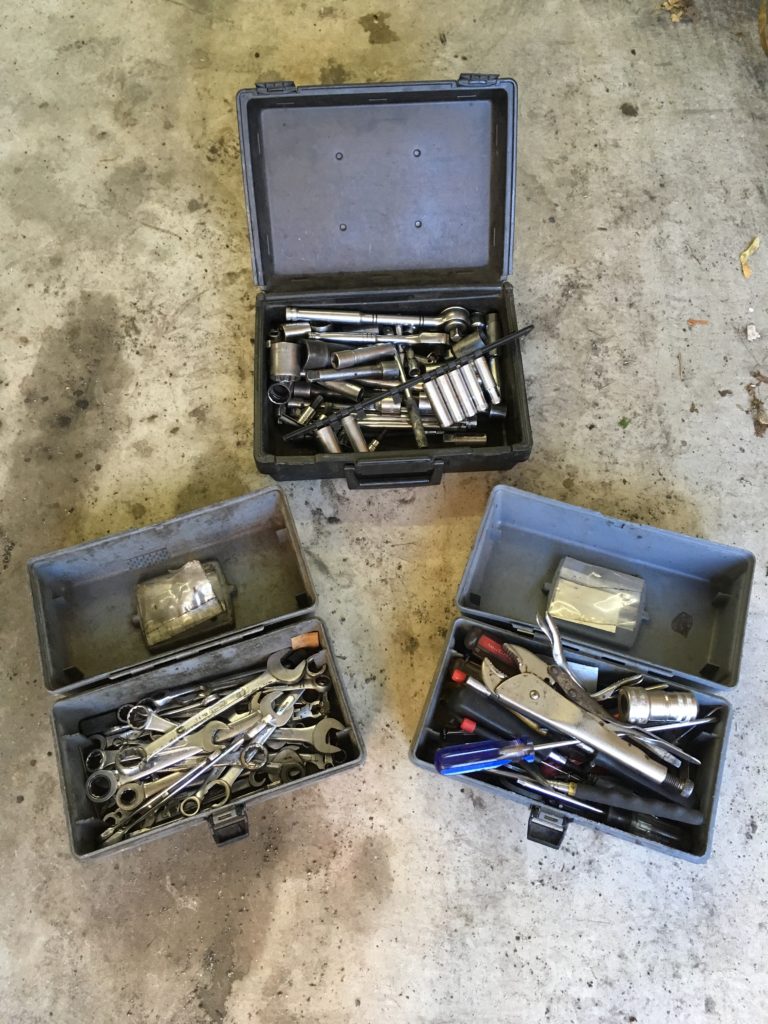
These three plastic boxes held my most frequently-used tools.
This setup also had the benefit that these plastic boxes were what I grabbed whenever I took a road trip. In addition to being vetted as containing my most frequently-used tools, they were easy to lift in and out of the trunk.
My friend Paul Wegweiser laughs at me when we debate the issue of road tools. He likes to have a carefully-honed minimal set, barely larger than what’s in a 50-year-old vinyl 2002 tool roll, whereas I feel that if I use it often in the garage, I’m likely to need it on the road. Vive la différence.
The whole road-tools thing is its own topic, one about which I’ve written before. When I took Louie, the ’72 tii, on hisroad trip to the BMW CCA Foundation for its eleven-month stay in the “Icon” exhibit, I elected to put together a dedicated tool kit for the journey. I bought a medium-sized small plastic tool box—two levels with the tray—and populated it with the necessities. These were largely made up out of duplicates of what I had. I filled in the gaps with a few new items from Harbor Freight and a used-tool store near where I live. As Louie wound up going from the Foundation to Lance White’s place in Cincinnati, the tool kit sat in the trunk for nearly eighteen months. Now that Louie is back, I’ve tried to leave that tool kit intact as the road kit that I grab whenever I take any vintage car farther than around the block. (Well, I should say any of the vintage BMWs around the block; the Lotus is English, not metric, and I’ve yet to put something together for it that’s well thought out.)
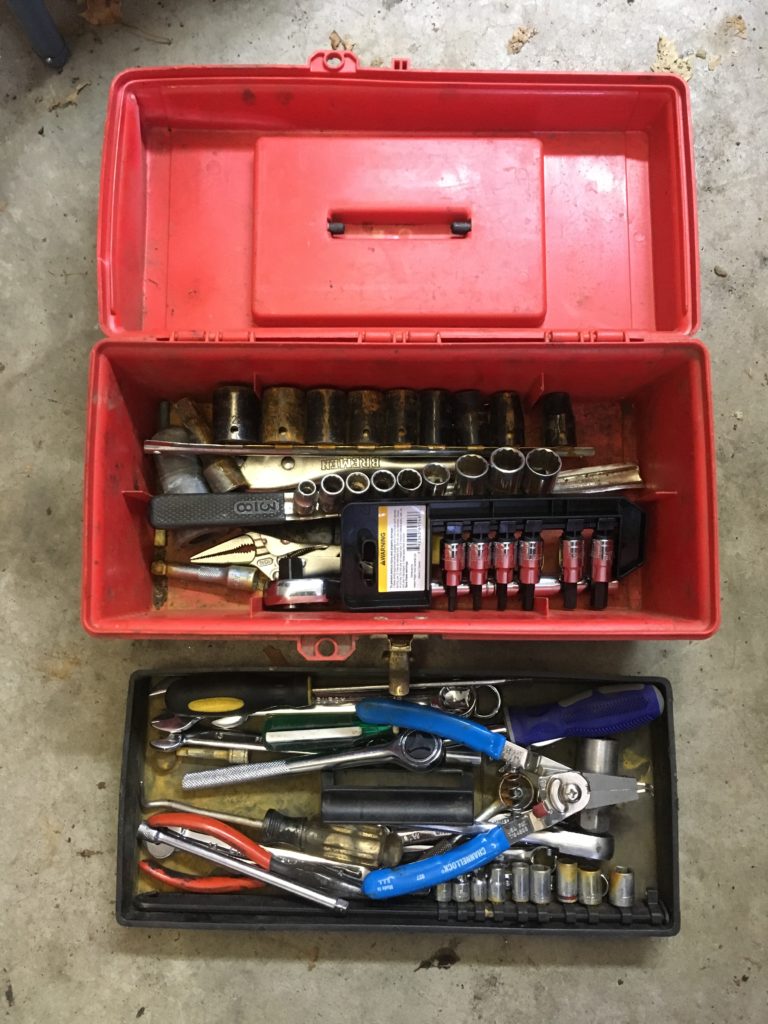
Louie’s road kit.
Even when I’m garaging three cars, space in the garage is tight enough that there’s not room for a permanent workbench or table. When I was rebuilding the Lotus engine last winter, I needed parts and assembly space, so I appropriated a folding card table and got hold of a plastic lab cart. All of the tools I needed were placed on the cart right next to the engine. Of course, after the Lotus engine was built, all of these convenient horizontal surfaces became a repository for crap.
When I bought Hampton, the 48,000-mile ’73 2002, last September, and needed for that car and Louie the ’72 tii and the 3.0CSi and the Lotus to spend winter in the garage, both the card table and the cart had to go. Since all of the tools had to come off the cart, it gave me an opportunity to rejigger the tool storage. At least for the winter, I got stuff out of the plastic boxes and into another full-sized metal toolbox I bought at a yard sale and put next to the big Craftsman.
As I wrote about a couple of weeks ago, when there are four cars in the garage, there’s very little space between them. In particular, the space on the left side of Hampton—between it and the tool boxes—is very slim. I immediately found that having to get up and side-step your way around cars to the tool box and back every time you need something is more than a productivity killer, it borders on an OSHA violation. But it’s what I’ve got.
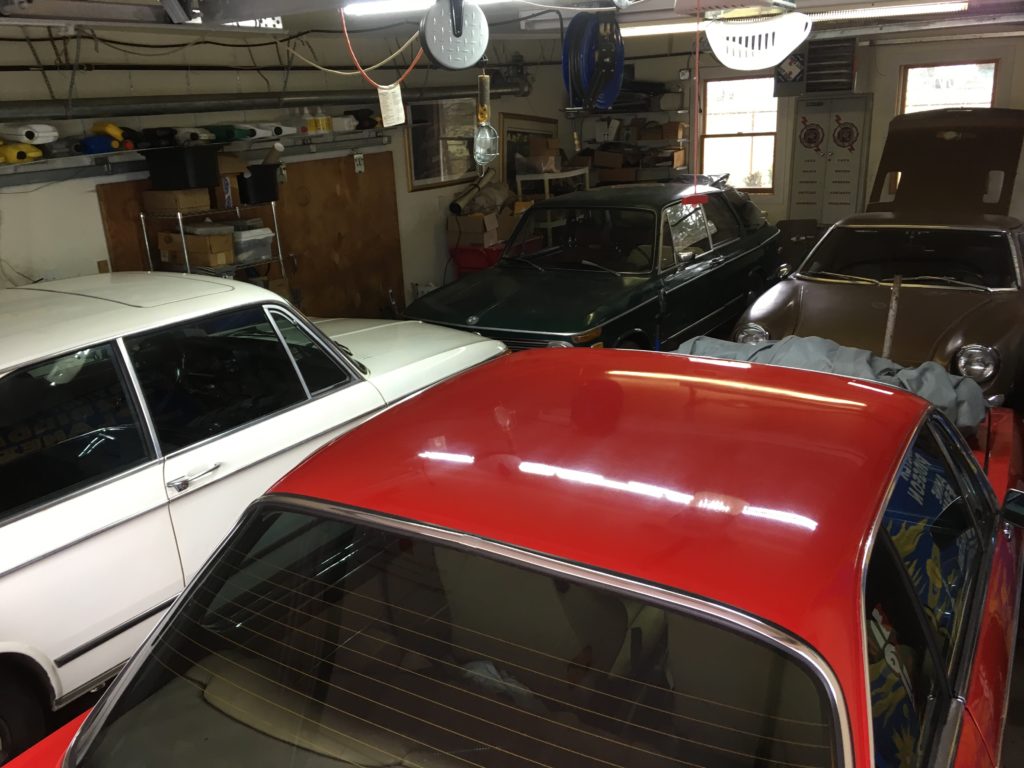
It’s tight in there.
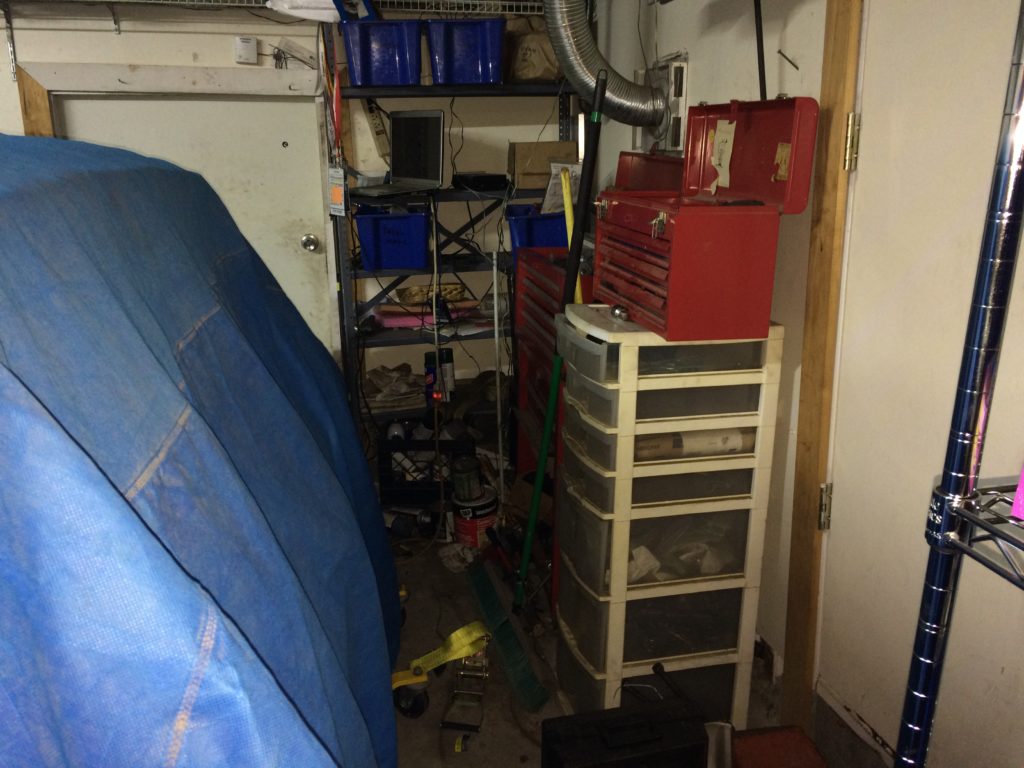
The toolboxes are on the far side of Hampton.
Last Christmas, my wife, Maire Anne, impulse-bought me a compact tool chest on wheels that doubles as a padded stool; it was on sale at Costco. At the time, I didn’t see how it would fit into my world (literally) and stuck it in the basement, but a few weeks ago I pulled it out to see if it would be useful.
And…it’s not great.
It is compact enough to fit easily between the two rows of cars, and it can be easily rolled around on its wheels—but with only three drawers, it’s really too small. The top drawer will fit all the 22-mm-and-smaller wrenches, but the middle drawer will only hold the 3/8″ sockets, ratchets, and extensions; it’s too small to also house the 1/2″ stuff. And the bottom drawer can fit the screwdrivers, but not the pliers; even one pair of full-sized Vise Grips is over capacity. For now, the overflow goes into a metal tool tray with a handle, stolen from the other red tool box. That tray usually sits on the padded part of the stool, so the “somewhere padded to sit” feature isn’t really being exploited.
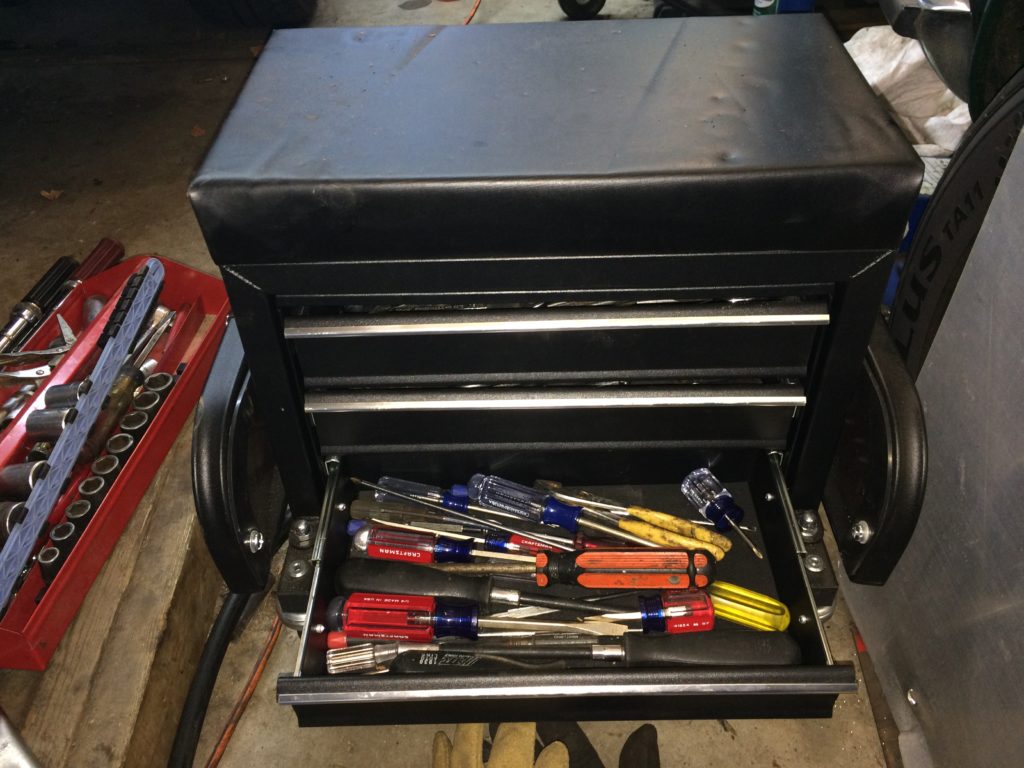
Not perfect, but workable.
To make matters worse, much of my wrenching time this winter has centered around the Lotus, so a variety of English sockets and wrenches are typically scattered under or near the car. Loose sockets, particularly the tall ones, actually are a serious safety hazard, as anyone who’s ever stepped on one and gone flying, Three Stooges-on-marbles-style, can attest. (Actually, the single most hazardous item in this vein is probably the obligatory one-foot length of one-inch pipe you use as a cheater bar. That thing is worse than a banana peel.)
Safety notwithstanding, in terms of storage efficiency, there’s an odd reversal that occurs with this packing-in of cars: Normally, anything on the floor in a garage is death, because it prevents the space above it from being used for anything useful, but with the cars packed in so tightly, at least things low on the ground can be stepped over. That is, a big multi-level tool chest on the periphery is space-efficient, but in a row between cars, it’s a blockade.
Other than more space, which isn’t going to happen at this address, or a toolbox that magically descends from the ceiling, or I-Dream-Of-Genie/Harry Potter-like skills that would allow me to telekinetically move tools from a remote toolbox into my hand, I’m not sure what a better solution is.
So if the next few weeks you read that I’ve landed in the hospital with a broken ankle and a fractured cheekbone, you’ll understand why.—Rob Siegel
Rob’s new book, Resurrecting Bertha: Buying Back Our Wedding Car After 26 Years In Storage, is available on Amazon here. His other books, including his recent Just Needs a Recharge: The Hack MechanicTM Guide to Vintage Air Conditioning, are available here on Amazon. Or you can order personally-inscribed copies of all of his books through Rob’s website: www.robsiegel.com.

